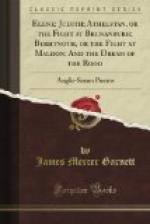However it may be, a poet named Cynewulf wrote the ELENE, and thereby left us one of the finest Old English poems that time has preserved, on a subject that was of great interest to Christian Europe. A collection of “Legends of the Holy Rood” has been issued by the Early English Text Society (ed. Morris, 1871), from the Anglo-Saxon period to Caxton’s translation of the Legenda Aurea; but they are arranged without system, and no study has been made of the date and relation of the several forms of the story. If Cynewulf made use of the Latin Life of Cyriacus in the Acta Sanctorum, he expanded his source considerably and showed great skill and originality in his treatment of the subject, as may be seen by comparing the translation with the Latin text in Zupitza’s third edition of the ELENE (1888), or in Professor Kent’s forthcoming American edition, after Zupitza. The Old English text was discovered by a German scholar, Dr. F. Blume, at Vercelli, Italy, in 1822, and the manuscript has since become well known as the Vercelli Book (cf. Wuelker’s Grundriss, p. 237 ff.). A reasonable conjecture as to how this MS. reached Vercelli may be found in Professor Cook’s pamphlet, “Cardinal Guala and the Vercelli Book.” A Bibliography of the ELENE will be found in Wuelker, Zupitza, and Kent. English translations have been made by Kemble, in his edition of the Codex Vercellensis (1856), and very recently by Dr. R.F. Weymouth, Acton, England, after Zupitza’s text (privately printed, 1888). A German translation will be found in Grein’s Dichtungen der Angelsachsen (II. 104 ff., 1859), and of lines 1-275 in Koerner’s Einleitung in das Studium des Angelsaechsischen (p. 147 ff., 1880). A good summary of the poem is given in Earle’s “Anglo-Saxon Literature” (p. 234 ff., 1884), and a briefer one in Morley’s “English Writers” (II. 196 ff.).
The ELENE is conceded to be Cynewulf’s best poem, and ten Brink remarks of the ANDREAS and the ELENE: “In these Cynewulf appears, perhaps, at the summit of his art” (p. 58, Kennedy’s translation). The last canto is a personal epilogue, of a sad and reflective character, evidently appended after the poem proper was concluded. This may be the last work of the poet, and there is good reason for ten Brink’s view (p. 59) that “not until the writing of the ELENE had Cynewulf entirely fulfilled the task he had set himself in consequence of his vision of the cross. Hence he recalls, at the close of the poem, the greatest moment of his life, and praises the divine grace that gave him deeper knowledge, and revealed to him the art of song.”




